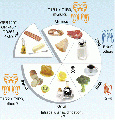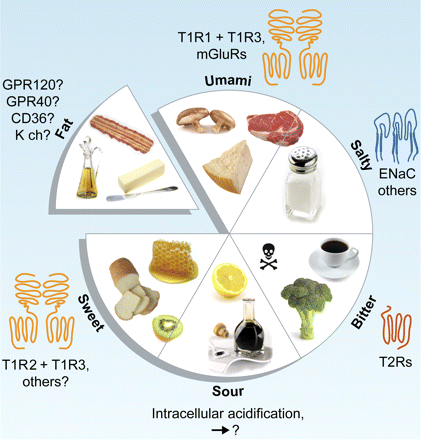File:Taste qualities.gif
Taste_qualities.gif (421 × 440 pixels, file size: 82 KB, MIME type: image/gif)
Taste qualities
Taste qualities, the taste receptors that detect them, and examples of natural stimuli. Five recognized taste qualities—sweet, sour, bitter, salty, and umami—are detected by taste buds. Bitter taste is thought to protect against ingesting poisons, many of which taste bitter. Sweet taste signals sugars and carbohydrates. Umami taste is elicited by l-amino acids and nucleotides. Salty taste is generated mainly by Na+ and sour taste potently by organic acids. Evidence is mounting that fat may also be detected by taste buds via dedicated receptors. The names of taste receptors and cartoons depicting their transmembrane topology are shown outside the perimeter. Bitter is transduced by G protein–coupled receptors similar to Class I GPCRs (with short extracellular N termini). In contrast, sweet and umami are detected by dimers of Class III GPCRs (with long N termini that form a globular extracellular ligand-binding domain). One of the receptors for Na+ salts is a cation channel composed of three subunits, each with two transmembrane domains. Membrane receptors for sour and fat are as yet uncertain.[1]
Copyright information
© 2010 Chaudhari and Roper This article is distributed under the terms of an Attribution– Noncommercial–Share Alike–No Mirror Sites license for the first six months after the publication date (see http://www.rupress.org/terms). After six months it is available under a Creative Commons License (Attribution–Noncommercial–Share Alike 3.0 Unported license, as described at http://creativecommons.org/licenses/by-nc-sa/3.0/).
- Note - This image was originally uploaded as part of an undergraduate science student project and may contain inaccuracies in either description or acknowledgements. Students have been advised in writing concerning the reuse of content and may accidentally have misunderstood the original terms of use. If image reuse on this non-commercial educational site infringes your existing copyright, please contact the site editor for immediate removal.
References
1. Nirupa Chaudhari, Stephen D Roper The cell biology of taste. J. Cell Biol.: 2010, 190(3);285-96 PMID:20696704
- ↑ <pubmed>20696704</pubmed>
File history
Click on a date/time to view the file as it appeared at that time.
| Date/Time | Thumbnail | Dimensions | User | Comment | |
|---|---|---|---|---|---|
| current | 00:12, 19 September 2012 |  | 421 × 440 (82 KB) | Z3330986 (talk | contribs) | ==Taste qualities== Taste qualities, the taste receptors that detect them, and examples of natural stimuli. Five recognized taste qualities—sweet, sour, bitter, salty, and umami—are detected by taste buds. Bitter taste is thought to protect against in |
You cannot overwrite this file.
File usage
The following page uses this file:
